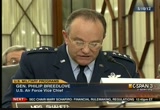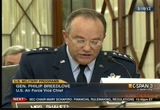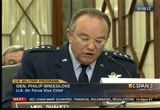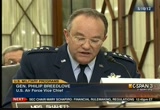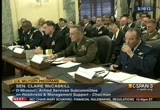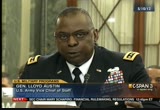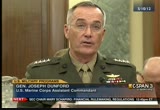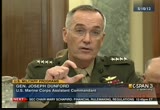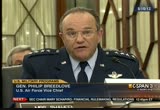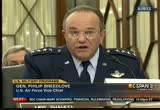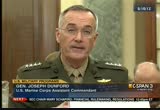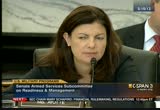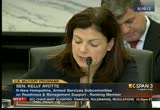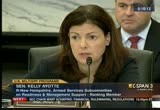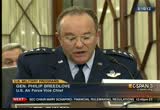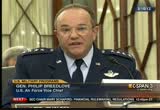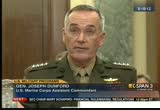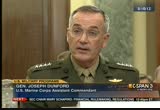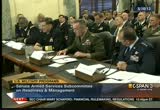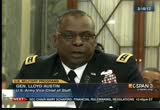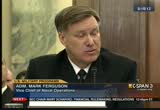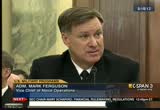tv [untitled] May 14, 2012 11:30am-12:00pm EDT
11:30 am
first time in 20 years that the air force did not fly an air tasking sortie over iraq. madam chairman, senator, i would like to point out that over two-thirds of our uniformed airmen have taken an oath to defend our nation and have joined our service during a time of war, during a time of continuous operation. and for that i couldn't be more proud to serve alongside these dedicated airmen and americans. these airmen are fully joined to the fight and consistently demonstrate their commitment to this joint team you see in front of you and in the support of our combatant commanders and our nation's interests. last year we saw this commitment at full capacity as our airmen simultaneously provided humanitarian support to our friends in japan, executed a large presidential airlift in south america, supported the nato no-fly zone to protect lives in libya, and all the while fully employed with counterinsurgency operations in iraq and afghanistan. our force capacity of the future may not support this high level
11:31 am
of sustained simultaneous operations. hence i am immensely proud of how our airmen have performed for the past 20 years and across all spectrums and with what you have seen, a very high tempo. this intense level of performance has not come without a cost. our force is stressed. we have continually gotten smaller. next year we will be the smallest we have been since the inception of the united states air force in 1947. our aircraft are old, older than they've ever been, with the average age of our fighters at 22 years, bombers at 35 years, and tankers, the oldest of the fleet, at 47 years. what really concerns me is the challenges we face to get our full spectrum training. we are proficient in the current counterinsurgency fight. we have had to put high-end full spectrum training on the back burner, which has the greatest effect on our combat air forces.
11:32 am
other more recent concerns are the increase in fuel prices and the higher than expected overseas contingency operations costs. together they have resulted in a current-year bill that is significantly greater than we expected. we are working hard with dod leadership to address the shortfall to avoid actions that might harm readiness. but if unable to reallocate funds with congressional approval, we will have little choice to shift resources within our operational and maintenance accounts, which could have detrimental effects on our readiness. despite these fiscal pressures, there continues to be an increasing demand for airspace and cybercapability, which is evident in our nation's new defense strategic guidance. in order to keep faith with the american people and provide our unique capabilities upon which the entire joint team so greatly relies, it is imperative that we balance our force structure to preserve our readiness and maintain our risk-balanced
11:33 am
force. in doing so, we must rebalance our active and reserve component mix to ensure we can meet joint force requirements while not exceeding the ratio across the entire force. while no plan is free of risk, our analysis tells us that we are at increased but manageable risk as measured against this new strategic guidance. we are concerned that efforts aimed at retaining force structure are out of balance with our strategic guidance or not accompanied by sufficient support and fund willing lead us to the road of a hollow force. force structure is a key to our future. as we responsibly rebalance this force, we remain committed to advancements in technology and future investments to continually sharpen our sword. although we will be smaller, we will remain an effective and ready force. madam chairman and committee members, i am confident in our ability to succeed through the tough times ahead.
11:34 am
because i believe in our nation's airmen, who like their fellow sailors, marines, coast guardmen, are dedicated to excellence, selfless service, and sacrifice. thank you for your continued support of your united states air force and of your airmen. i look forward to your questions. >> thank you very much, gentlemen. since the turn of the century, we have been involved, heavily involved, in combat operations which have required our personnel to deploy frequently and caused incredible wear and tear on both people and the vital equipment that we need for readiness. and frankly, we've had little time to train for anything other than counterinsurgency. notwithstanding the steps taken by congress to increase investments, reported readiness rates have significantly declined over the past ten years. record funding in still significant decline. in past readiness subcommittees
11:35 am
we have been told by your predecessor that increase in readiness will not occur until we see a decrease in tempo. now we have the drawdown in iraq and surge recovery in afghanistan this year and phased drawdown thereafter. can you give tuesday what your best protections are as to when we will see a more positive readiness trend in light of the drawdown that is currently under way? >> thank you, chairman. from the army's perspective, we're already beginning to see that as the tempo as we have come out of iraq, certainly we have more opportunities to train at home station. we are taking advantage of those opportunities. and again, as we retrograde our equipment and put that equipment through reset, more equipment is being made available.
11:36 am
so, we all already beginning to reap some of the benefits of the slowdown. and as you know, i was the guy at the very end in iraq who was charged with overseeing that reposturing effort, and i can tell you that that was very well done and a magnificent job by our joint force to do that. but as we -- as general dunford and i have both pointed out, it will take two to three years beyond the complete retrograde of our equipment out of afghanistan to reset the equipment. and we certainly need to be funded to do so and would appreciate any help that you could provide us in doing it. >> anybody else? >> madam chair, as you pointed out, there's really three components in this -- the
11:37 am
training piece, the people piece, and the equipment piece. we will begin as we have started to recover forces from afghanistan our deployment has expanded. we are at a point where our squadrons and battalions were deploying for seven months, home for seven months, and redeploying for seven months. that's expanded two between 11 and 13 months between deployments. that's helped us on the training side. as you recover, the force, will start filling personnel gaps we have had. i would emphasize what the general said. and before you actually start to see increase readiness reporting from our moments of home station is going to be the equipment piece. that's two to three years from the time the equipment actually gets home, not from the time the units redeploy. our best estimates right now, based on 2014 drawdown from afghanistan would be sometime around 2017 is when we would start to see significantly increased reporting. i mentioned that 67% of our units at home station were
11:38 am
in degraded red r readiness. what i was really referring to was a scale of c3, c4 scale of one to four readiness. units report the lowest level of readiness in manning, training and equipment. so 61% of the units that report degraded readiness as a result of equipment shortfalls. not only do we have to get the equipment home, but we've got to reset that equipment going through our depots or replacing equipment that has been destroyed. a combination of the procurement process and the depot maintenance process, our best estimate is, again, that two to three years not from the time the marines come home but from the time their equipment comes home from afghanistan. >> the navy and air force disagree with the two to three year assessment? or does that sound about right for from your perspectives also? >> madam chair, from our perspective, the force demand is different on the navy as we withdraw out of land campaigns. we have sustained training our forces at a major combat level
11:39 am
through this ten-year period. what you saw in this budget, we invested in training and depot maintenance, brought it up to 110%. we remain reliant on the funding and we see that it will take at least two to three years for a transition, perhaps longer for us to sustain readiness levels. >> madam chair, the difference for us is much as you saw after we came out of desert storm one and desert two. immediately following a combat -- a change in mission like we're seeing in iraq now, the actual requirement for air forces goes up in order to facilitate that retrograde, to cover with kinetic fires and isr, to reduce the risk for those ground combat soldiers and marines as they do that mission. and we are seeing that now. even as we are coming out of iraq act three months ago, our deployed fighter squadron was up to about 8 1/2. it is up to 11 1/4 now. that's much what we expect.
11:40 am
also, on the lift side of the house, especially if we do not get movement in the pac g-locks, as you know, much of the job of bringing home all the equipment that marines and army will need fall to the backs of the air force to haul out. there will be a considerable amount of time as the we affect this retrograde, especially if it is an increased by the air, before the air force will even begin to begin its rheetrofit a refit. so our start time could be significantly different than what you heard from my compatriots. it will take us some period of time between a year and a year and a half to get through the training cycles and things we need. >> since you touched on the closure -- the problems we're having on the border at pakis n pakistan, general breedlove, let me go to that question. it is rel rant obviously to the drawdown as we pull equipment and men and women out of afghanistan. it is obviously very important in terms of fuel costs.
11:41 am
you know, we -- it is a huge bill that we i think people forget that nobody buys more fuel in the world than we do. and when it's expensive, it really is a gut punch to the budgets of our military. i know that we have to pay almost three times the normal rate to go through the northern distribution network that we would have to typically expend going through pakistan. what effect is this closure going to have on getting equipment out, getting everything out we need to get out, and more importantly on getting the fuel in we need to continue to support the mission that we have ongoing in afghanistan? >> ma'am, i'll take the first shot at that. there's two effects on the united states air force and its ability to support the joint
11:42 am
team that fuel brings. first, all, in this current year, as you are aware, the reprice on fuel is going to cost us approximately $1.3 billion that was not in our original plan. that will be money we will have to find in other sources assuming you approve them inside of our budget. so fuel reprice is a big deal for us. second of all, if the pac g-locks do not open and we cannot count on the flow that was planned for that, when we originally budgeted for our fuel for this next year, and now we have to increase the amount of fuel we use to begin to fly out much of this retrograde by air, that will again be an unplanned oco bump up in the requirements for the air force. >> madam chair, i would add one quick point to the points you made and the one general breedlove made. it goes back to the question of when would we be reset to a high
11:43 am
level of readiness. obviously, the longer it takes to get our equipment out of afghanistan and northern distribution network would take longer to get our gear out, the longer it will take to restore that high level of readiness. so in addition to implications of cost, factor of time is an issue. >> yeah, i think a lot of americans don't understand that the stresses with pakistan have many implications, not just the direct implication of are they our friend, are they our enemy, what exactly are they, and who can we trust within pakistan? but it has a dramatic impact on the budgets of our military as it relates to operational requirements in afghanistan and drawdown in afghanistan. thank you. senator ayotte? >> thank you, madam chair. i wanted to ask each of you in the chairman of the joint chiefs of staff, the conclusion of the chairman's risk assessment that
11:44 am
he submitted to us. he says that the services will need to "conceive of a new risk paradigm." can you help me about what that means, if we are conceiving of a new risk paradigm? >> well i think as you create a new strategy, you certainly look for ways to balance the risk that you're going to accept. and of course you focus on the most dangerous aims and then also you consider the most likely things that are going to cur. and so i think what the chairman is getting to with that, at least my read of this, is that, you know, each time that you revamp your strategy you're going to have to look at things through the lens of kind of the context of today and what the
11:45 am
threat offers in the future. >> general, just as a follow-up on that, just listening to it from my perspective, i assume that's what we did whenever we would issue a risk assessment. so, when i hear the words "new risk paradigm," it makes me wonder if our overall view of how we are going to meet risks or asays them has changed. has it or hasn't it? >> certainly our methodology for conducting risk assessments has not changed. but the context has changed a bit in terms of the state of the world. where we are today is absolutely -- what we are seeing today is absolutely different from what we saw two years ago, actions in the middle east, those types of things. >> i appreciate your answer.
11:46 am
i am asking you to assess what somebody else means. to make it more helpful, let me direct my question more specifically which i think will be relevant. so with the proposed $487 billion in reduction, obviously we are talking about the first year here for 13 of the reductions over the 10, you have got proposed significant end strength reductions, combat unit eliminations, weapons systems, other cost-cutting measures that we are talking about today. and there is no question that these reductions are going to impact the ability of each service to respond to their the request of their combatant commanders. and what i think is important to understand is when you look at what the secretary said and i quoted in my opening statement, you can't take half a trillion out of defense budget and not occur additional risk, he said there is no margin for error.
11:47 am
what in each of your opinions in each of the services is the most risk we are incurring to the extent you can talk about them? and if you could, what are the risks that we're incurring here that keep each of you up at night? and if we were to add money back in this budget to meet where we have just cut it right on the edge, no margin for error and you had that choice, i'm not asking you to make the request of us, but if you could and now think about what keeps you up at night, what would you tell us? >> ma'am, isle take a shot at it first. and i think i understand where you are trying to go. there are a few things i think -- as you mention we are taking cuts right in 13. in the air force budget it is almost 200 aircraft in the first year, number of people.
11:48 am
and that speaks to capacity. our overall capacity is coming down. and in our new strategic guidance, the ability to swing capacity from one to the second conflict is a key to how well we will support the join force. and what keeps me up at night are two things. that is the time to respond, if we are fully engaged in the first, will we have time to get to the objectives we need in the first engagement in order to properly support the second engagement with our reduced capacity, which is evident from the cut and number of people and aircraft. and then the second thing that worries me is really unchanged from last year and hasn't changed much in relation to this strategy, and it's the same thing i spoke to in the readiness hearings last year, and that is that we do have pretty intense pressure on what
11:49 am
we call our low-density, high-demand assets, the jstars, the rivet joints, the isr fleet in its total, all of those things which are sized for about one conflict and not two. and as you know now some of those isr assets are deployed those isr assets are deployed at less than one-to-one deployed ratio. the ability to respond from one conflict to the next with those low-density, high-demand things are what keeps me up at night. >> general? >> senator, i would like to go back to the original question and talk act the risk. there is really two kind of risk -- strategic risk, the chairman largely talks about. then he alludes to institutional risk. the service's ability to create balance between maintaining high quality people, meeting combatant commander's requirements, and home station
11:50 am
readiness, i spoke about earlier, maintaining a proper modernization profile so years from now we'll have the capabilities that we need, and also properly maintaining our infrastructure, something that madam chair mentioned. and so what mentioned. what we have done, we have done things differently in a sense we project the next eight to ten years will be a period of austerity. that caused us to go back and take a look at all of our requirements and make sure we understand what we have to have and what's nice to have and we made hard choices inside to ex end it our equipment out past what may have been the normal service life. for example, in our ground tactical vehicles now we only plan to modernize 20% of the pleat between now and 2027 and 2028. we decided to go back and we think it is manageable risk, to go back and look at the rest of fleet and do things that will extend the service life out for five or seven years beyond what it might otherwise have been in terms of being in service. managing institutional risk is
11:51 am
frankly what keeps me awake at night. a piece of that, we call it five pilla pillars, a piece is certainly meeting the commander's demand and the command as admiral ferguson mentioned exceeds our supply at this particular time. the other thing, i look out over the next eight, ten, 12 years, it is maintaining balance on what i described as the institutional pillars risk and making sure we don't inadvertently hollow out one of those pillars only to fill the recognize second or third or effects they have to deal with eight or ten years from now and i would say the last thing is all of us came in the military in a late 1970s and i was a platoon commander in the post vietnam days and i know what a hollow force is because i was a platoon commander in a hollow force and i will tell you the number one thing that keeps me awake at night is being part of anything that would cause the united states marine corps to look like it did in the 70s as opposed to 2012. that's what keeps me awake at
11:52 am
night. >> thank you, general. >> senator, what i focus a lot of my attention on is balancing the present versus the future. in that those future capabilities that the united states navy and marine corps will need going forward as we face increasing competition and antiaccess aerial denial he can it nolgs and nation that is develop technologies and capabilities trying to thwart our ability to operate from the sea. so that future balance investment has to be weighed against maintaining the current readiness of the force as we operate it. what you saw in our budget do is we reduced force structure. we took out older assets to make available those assets. we looked at our other investment accounts and made critical investments in the capabilities we needed, preserving research and development and the new technologies. we reduced procurement in some areas or delayed them to outside the fit up for affordability and really focusing on preserving
11:53 am
the force. these investments we made today were focused on ordinance, depo maintenance to sustain the current readiness. the risk for us really boils down to capabilities. can we pace rising peer competitors, capacity, do we have the forces available to flow the combatant commanders with an acceptable level of risk and then how it affects and certainly response times and what our presence levels around are in the fleet. we think in this budget we try to achieve that balance with acceptable level of risk. >> i will just add, senator, that these remain challenging times and we're faced with a variety of issues and for me foremost among those issues is supporting the effort in afghanistan and then while doing that striking a balance in all of the other requirements that we're faced with, and so i
11:54 am
routinely work along with the chief to make sure that we have a healthy balance between our efforts and modernization and in strength and readiness and just keeping that balance routinely is really what we're focused on. also, i worry a lot about the health of our force and having said that, i also said earlier that i believe that we have the most resilient force that we could have ever imagined and 15 years ago if you told me that we're going to remain -- going to be at combat for a decade and be able to keep our soldiers and family members with us, i would not have believed that, but as you look back and see how we have been able to adapt across the military but specifically in the army, to meet the demands and keep our force with us, and take care of our troops, i think
11:55 am
that's quite impressive and i am really concerned about our ability to continue to do that and i will remain focused on that for the foreseeable future because as you well know, people is what the army is all about and so our ability to do that and keep faith with our soldiers and families is something i remain concerned about. >> thank you. >> thank you, senator ayotte. senator begich. >> thank you very much, madam chair. i have a couple broad questions and then general breedlove, i also have the air force on my mind so i will come to you in a second and i will walk through -- these are very the first just yes or no. do you support the law of the sea and we can start here. >> i will go first. i do, and navy leadership supports it and uniform side and
11:56 am
provides several positive benefits. one, a legal framework for interactions and resolution of disputes at sea and, second, it allows us to shape the resolution of those disputes as a member and a party to the treaty and, third, we feel comfortable that intelligence operations and military operations will not be subject to the jurisdiction of any international court or evolution, so we're comfortable and we support accession of the treaty. >> i would also like to respond to that. the navy knows so i know that on this issue. i will horde there. second, just in a nutshell, any comment in regards to -- maybe i will start with the navy also in regards to the future of the art ican military need or positioning. >> i think we're looking at the arctic carefully.
11:57 am
we have an on going effort in conjunction with our allies, the canadians, norwegians and others in discussing that. i think there is three aspects. there is a security aspect. there is a safety aspect. certainly an environmental aspect that we're concerned about in the arctic, and i think the initial actions for us is as the area becomes free of ice during the summer months and we start to see shipping and oil exploration and other activities up there, i think that there will be a necessity for us to begin to think about having a maritime awareness of what's occurring in the arctic, but i don't see at the present time or within several years a requirement for military operations. >> very good. >> anyone else want to respond on that one? >> we routinely operate up there now with our suband have gained a lot in those operations. >> very good. thank you very much. general breedlove, let me go to
11:58 am
you. you know where i am going. i want to talk about ellis son air force base and as you know there is an effort to relocate the f-16, and we've had conversation and my concern is volume of civilian force n my words, i see this as a back door brack without the public process and the need and here is the real question and what i ask everyone and every meeting i have if you're the air force and you're wearing anything that indicates such you get these questions and i look for the answers. did the air force conduct a comprehensive analysis and assessment to validate the cost savings? as you know in the first year it is 3.5 and five years it is 169 million and when i say comprehensive, not just for the fiscal year '13 but for the spread and then other services that may be affected. example a is the joint training
11:59 am
facility that's on there, mobility center, that the army uses to move people, the striker force. they use it. it is on air force base and air force personnel participate in that effort. when you reduce down that force the army will have to pick up a tab on this and i don't want to pitch you all here in the middle of this but i look at it from a dod perspective and not a service perspective of the savings, so is there a comprehensive cost analysis and then if the answer is yes, is it gross in the sense of what it saves or is it net in what it saves because i believe it is not the latter. it is not net. it is a gross number. please. >> senator, as you know, and we have talked a little bit about this with your staff, i think the turn of the discussion or the question is what you would call how detailed is that analysis? we did do a detailed analysis
115 Views
IN COLLECTIONS
CSPAN3 Television Archive
Television Archive  Television Archive News Search Service
Television Archive News Search Service 
Uploaded by TV Archive on

 Live Music Archive
Live Music Archive Librivox Free Audio
Librivox Free Audio Metropolitan Museum
Metropolitan Museum Cleveland Museum of Art
Cleveland Museum of Art Internet Arcade
Internet Arcade Console Living Room
Console Living Room Books to Borrow
Books to Borrow Open Library
Open Library TV News
TV News Understanding 9/11
Understanding 9/11
